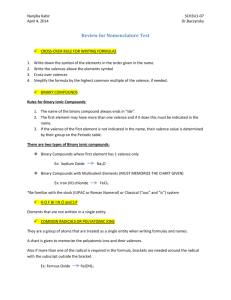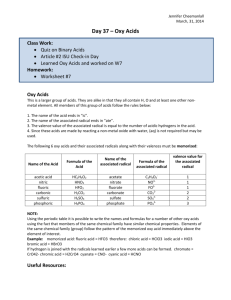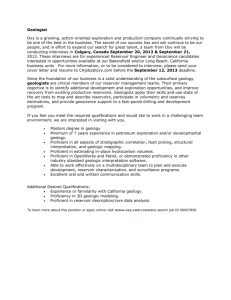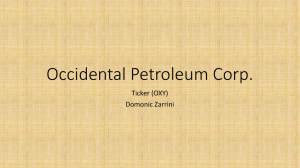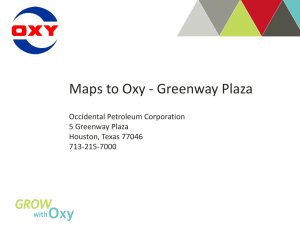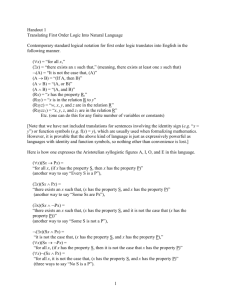Development of 2 generation oxyfuel CFB technology
advertisement
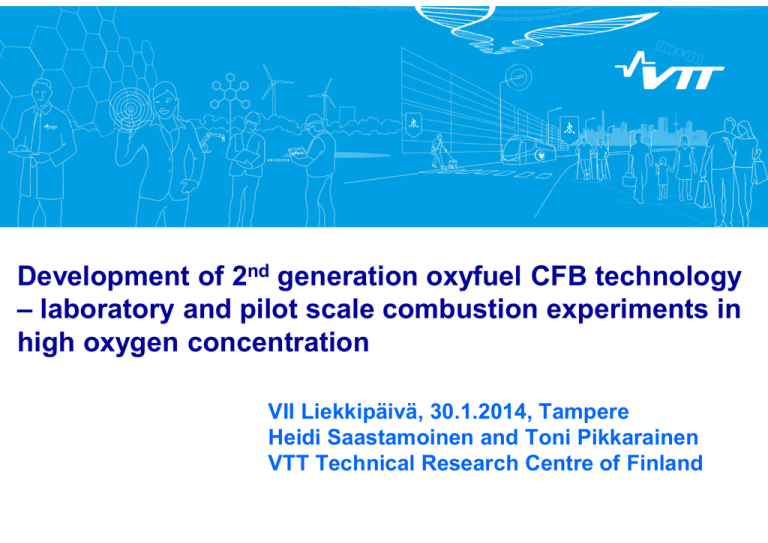
Development of 2nd generation oxyfuel CFB technology – laboratory and pilot scale combustion experiments in high oxygen concentration VII Liekkipäivä, 30.1.2014, Tampere Heidi Saastamoinen and Toni Pikkarainen VTT Technical Research Centre of Finland Content Introduction to O2Gen – project Experimental work and preliminary results: Bench scale BFB Pilot scale CFB What next 2 O2Gen Optimization of Oxygen-based CFBC Technology with CO2 capture Project under EU 7th FP started 10/2012, duration 3 years total budget 11.9 M€ (EU contribution 6.6 M€) Consortium contains 11 partners 4 companies and 7 research organisations from Spain (5), Finland (3), France (1), Italy (1) and Poland (1) 3 O2Gen Optimization of Oxygen-based CFBC Technology with CO2 capture The project objective is to demonstrate the concept of the 2nd generation oxyfuel combustion that reduce significantly (around 50%) the overall efficiency penalty of CO2 capture into power plants, from approximately 12 to 6 %-points. The efficiency improvements will be achieved by the use of higher O2 concentrations in oxyfuel combustion reducing the flue gas recirculation and energy penalty (also enabling boiler size reduction and thus cost reductions) integration of ASU (air separation unit) and CPU (CO2 processing unit) with the power plant reducing energy penalties more efficient oxygen production, and CO2 purification and compression steps As a result, conceptual design for 600 MWe scale 2nd generation oxygen-fired CFB power plant will be created 4 O2Gen Optimization of Oxygen-based CFBC Technology with CO2 capture Motivation: Decrease the costs of CCS and making the way to towards competitive commercialization of oxy-CFB based CCS technology 5 Fluidised bed test facilities Bench scale BFB and pilot scale CFB http://www.vtt.fi/img/research/ene/combustion/VTT.html 6 Fuel impulse tests Objectives and test matrix Objectives in fuel impulse tests are to solve how high O2 concentrations affect the • char reactivity of coal • emission (NO, CO, SO2) formation Test Spanish Anthracite 1 Spanish Anthracite 2 Spanish Anthracite 3 Spanish Anthracite 4 Spanish Anthracite 5 Spanish Anthracite 6 Spanish Anthracite 7 Spanish Anthracite 8 Polish Bituminous coal Polish Bituminous coal Polish Bituminous coal Polish Bituminous coal Polish Bituminous coal Polish Bituminous coal Polish Bituminous coal Polish Bituminous coal 1 2 3 4 5 6 7 8 Fraction, mm 0.5-2 0.5-2 0.5-2 0.5-2 4-8 4-8 4-8 4-8 0.5-2 0.5-2 0.5-2 0.5-2 4-8 4-8 4-8 4-8 Gas composition for both prim and sec O2 feed (%) CO2 feed (%) 5 15 30 50 5 15 30 50 5 15 30 50 5 15 30 50 95 85 70 50 95 85 70 50 95 85 70 50 95 85 70 50 T 850 850 850 850 850 850 850 850 850 850 850 850 850 850 850 850 prim, (CO2+O2), Nl/min sec, (CO2+O2), Nl/min 5 5 5 5 5 5 5 5 5 5 5 5 5 5 5 5 5 5 5 5 5 5 5 5 5 5 5 5 5 5 5 5 7 Bench scale fuel impulse tests: O2 responses • When the oxygen concentration in primary and secondary gas increases combustion rate increases • Combustion of volatiles, char gasification and combustion occur almost simultaneously in high oxygen combustion, whereas in low concetrations and with larger particles these phases separate • Combustion of bituminous coal occurs faster compared to anthracite due to higher volatile content of fuel 8 Bench scale fuel impulse tests: Temperature, CO • Peak temperature increases along with the increase in oxygen concentration • Char gasification in CO2 environment increases CO formation • CO formation is controlled by feeding secondary gas • The less oxygen is fed • the more CO forms • the longer CO forms 9 Fuel impulse tests: Nitrogen emission formation NO formation: • The rate of NO formation increases along with the increase in oxygen feed. • Formation of NO strictly follows the increase in temperature. • There no significant change in total amount of N released although the rate of NO formation increases • In 50% oxygen feed N2O formation increases and NO formation decreases 10 CFB-pilot tests Anthracite-petcoke blend Limestone Fuel power Ca/S total Bed temp. Feed gas O2 Primary gas O2 Secondary gas O2 Primary gas type kW mol/mol ºC % wet % wet % wet share-% 55 3.1 889 21 21 21 79 2.8 873 28 28 28 121 2.6 918 42 42 42 118 2.6 856 42 42 42 70 121 2.7 817 42 42 42 121 2.7 863 42 48 29 118 2.5 853 42 37 55 Estrella Fuel blend Anthracite/Petcoke 70/30 w-% Test Mode # air/oxy 1 air 2 3 4 oxy 5 6 7 Test matrix with anthracite/petcoke blend contained 7 tests: Test 1: air reference, medium temperature Test 2: oxyfuel 28% (ref. to 1st generation design), medium temperature Tests 3-5: oxyfuel 42% (ref. to 2nd generation design), 3 temperature levels Test 6-7: Oxyfuel 42%, oxygen staging (prim. O2 share 60...80%) Total feed gas flow and prim./sec. gas share (fluidisation conditions) were constant Also Ca/S-ratio (limestone calcium to fuel sulphur ratio, mol/mol) was kept as constant as possible 11 CFB-pilot tests Unburned carbon (UBC) losses 940 1.8 UBC to fly ash UBC to bottom ash 1.6 Bed temperature 920 UBC [% LHV] 900 1.2 1.0 880 0.8 860 Temperature [ºC] 1.4 0.6 840 0.4 820 0.2 800 0.0 Test 1 Test 2 Test 3 Test 4 Air Oxy 28% Oxy 42% - high T Oxy 42% medium T Test 5 Test 6 Test 7 Oxy 42% - low Oxy 42% - high Oxy 42% - low T prim. O2 prim. O2 In all tests UBC losses were low, <1.6 % of fuel LHV The lowest UBC was measured from high temperature, high-O2 test 3, as expected 12 CFB-pilot tests SO2 formation and capture – tests at medium temperature SO2 emission [mg/MJ] Calcium utilisation [%] Ca/S total [mol/mol] SO2 retention [%] 4.0 100 94.6 97.6 99.0 98.7 99.1 3.5 3.1 80 3.0 2.8 2.6 2.7 2.5 2.5 60 40 31 35 38 37 39 1.5 20 0 2.0 94 40 17 21 14 Test 1 Test 2 Test 4 Test 6 Test 7 Air Oxy 28% Oxy 42% Oxy 42% - high prim. O2 Oxy 42% - low prim. O2 Ca/S total molar ratio SO2 emission, Ca utilisation, SO2 retention 120 1.0 Lower SO2 emissions and better sulphur capture in high-O2 oxyfuel conditions (at ~860ºC) Also at 28% oxyfuel conditions the sulphur capture was better than in air-firing 13 CFB-pilot tests SO2 formation and capture – high-O2 oxyfuel conditions SO2 emission [mg/MJ] Calcium utilisation [%] Bed temperature SO2 retention [%] 940 160 920 120 900 100 98.2 99.0 98.7 99.1 880 91.3 863 856 80 853 840 60 817 40 38 38 20 0 860 820 34 37 39 Ca/S total molar ratio SO2 emission, Ca utilisation, SO2 retention 918 140 800 31 17 140 21 14 Test 3 Test 4 Test 5 Test 6 Test 7 Oxy 42% - high T Oxy 42% medium T Oxy 42% - low T Oxy 42% - high prim. O2 Oxy 42% - low prim. O2 780 Clear effect of temperature (tests 3-5), temperatures >850ºC were favored O2-staging had no significant effect (tests 4 and 6-7) 14 CFB-pilot tests SO2 formation and capture – calcination/carbonation Bottom ash 46 30 43 25 40 20 37 15 34 10 31 5 28 0 CaCO3 [%] CaO [%] CaSO4 [%] Ca utilisation Test 1 Test 2 Air Oxy 28% 0.42 13.77 15.64 30.5 4.17 18.28 23.38 35.1 Test 3 Test 4 Test 5 Oxy 42% high T 0.83 19.99 25.12 37.6 Oxy 42% medium T 1.67 20.08 27.84 38.1 Oxy 42% low T 32.50 2.08 19.08 34.0 Test 6 Test 7 Calcium utilisation [%] Mass share [%] 35 25 Oxy 42% Oxy 42% high prim. O2 low prim. O2 2.50 1.67 18.69 19.35 24.99 26.22 36.9 39.3 At low temperature and high CO2 partial pressure, CaCO3 is not calcined to CaO (direct sulfation to CaSO4) From the bottom ash analysis it can be seen that poor sulphur capture in test 5 was due to slow direct sulfation of CaCO3 (main part remained as CaCO3) 15 CaCO3 – CaO equilibrium 1 Equilibrium curve according to Marion et al. 0.9 Test 1 Air Test 2 Oxy 28% 0.8 CO2 partial pressure [atm] Test 3 Oxy 42% - high T 0.7 Test 4 Oxy 42% - medium T Test 5 Oxy 42% - low T 0.6 Test 6 Oxy 42% - high prim. O2 0.5 Test 7 Oxy 42% - low prim. O2 0.4 CaCO3 CaO 0.3 0.2 0.1 0 700 725 750 775 800 825 850 875 900 925 950 975 Temperature [°C] 16 CFB-pilot tests Formation of nitrogen oxides NO emission [mg/MJ] N2O emission [mg/MJ] Bed temperature 940 80 78 918 920 70 69 900 889 873 50 54 880 863 856 40 853 860 840 30 817 24 20 16 10 9 0 820 21 20 14 12 Temperature [ºC] Emissions [mg/MJ] 60 18 15 800 8 5 780 Test 1 Test 2 Test 3 Test 4 Air Oxy 28% Oxy 42% - high T Oxy 42% medium T Test 5 Test 6 Test 7 Oxy 42% - low T Oxy 42% - high Oxy 42% - low prim. O2 prim. O2 NO and N2O emissions were clearly higher in air-firing In high-O2 tests: NO was higher and N2O lower than in 28% oxyfuel at comparable conditions NO increased and N2O decreased with increasing temperature O2-staging had relatively small effect on NO or N2O 17 Next Second set of bench scale tests Temperature changes (750ºC & 950ºC) in high oxygen concentration combustion Model for bench scale combustor under development Target: to obtain parametres for pyrolysis, char gasification, char combustion and reactions of nitrogen species Particle model approach for bench scale results Bench scale modelling results will be implemented to one dimensional CFB furnace model for pilot scale CFB validation of the model with the data from air-firing and oxy-firing tests under widened operation range (O2 concentration 21...42 %) 18 ACKNOWLEDGEMENT The research leading to these results has received funding from the European Union Seventh Framework Programme FP7/2012 under grant agreement no 295533. Projects’ website: www.o2genproject.eu More about VTT’s combustion research and services: http://www.vtt.fi/img/research/ene/combustion/VTT.html 19 TECHNOLOGY FOR BUSINESS

